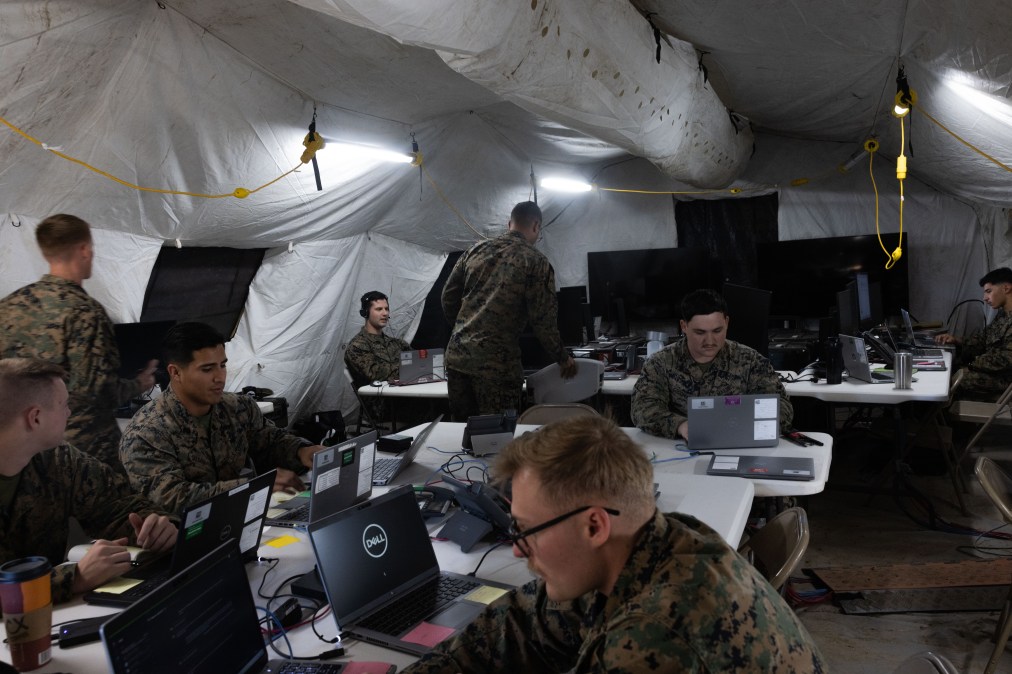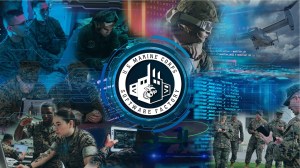Marine Corps’ new information command needs a common operational picture for digital landscape

In order to fully exploit the information environment, the Marines’ new information-focused command requires a common tool to be able to visualize it and understand it for commanders.
Activated last January, Marine Corps Information Command (MCIC) is designed to more tightly link the service’s information forces — including cyber, intelligence and space — in theater with the broader joint force. The need for a “common operational environment,” or COP, is essential for the organization to be successful in its remit to help leaders at all levels to be able to incorporate it into operations, as it is taking in activities from a variety of sources and forces.
“If information is a domain … you have to be able to see it, assess it, measure it, understand it, and where necessary shape and push it,” Maj. Gen. Ryan Heritage, commander of Marine Corps Forces Cyberspace and Marine Corps Forces Space Command, said in a December interview. “If you try to look at it in that context and know that the environment in which you’re operating is so dynamic that you’re going to have to have tools out there to measure or hopefully project changes in the environment before you’re even see them on the ground, before you’ve seen [them] physically, I think that will be invaluable to a future fight.”
Heritage was tapped to be the next deputy commandant for information.
One of the key aspects of the MCIC, which Heritage also commands, is to bring in and leverage what tactical information forces are doing, such as the Marine Expeditionary Force Information Groups — also known as the MEF Information Groups or MIGs. These forces were created in 2017 and support each MEF within the Corps. They integrate electronic warfare with intelligence, communications, military information support operations, space, cyber and communication strategy — all to provide MEF commanders with an information advantage.
“What we’re trying to do here at the Marine Corps Information Command is leverage what the MIGs are seeing, reporting and assessing. How do we bring that into the command here and then … how do I create a common operational picture for the information environment?” Heritage said.
The organization is looking to use artificial intelligence and machine learning tools, he noted.
“Something beyond PowerPoint that captures things like narratives, how it’s changing and why is that important to the platoon commander, why is it important to the combatant commander — how do I display that … and then leveraging AI/ML, how do I show changes in that environment that either are going to provide an opportunity for us or the tactical unit or they’re going to provide some sort of indication and warning?” he said.
The Corps is considered by many experts to be the lead service on the adoption of information, both from a concept perspective and in terms of the forces it has developed and deployed.
In 2022, the Marines published Marine Corps Warfighting Publication-8, which aims to describe the purpose and mechanics of using information as a warfighting tool for the entire service.
“From all my walking around observations, I have seen nothing but acceptance of the tenets of MCDP-8 and the power of information,” Heritage said.
He also noted that the service’s culture is part of why the Marines have taken information so seriously.
“Part of it is culture. I would tie that to the Marine ethos, Marine culture and understanding how information is a key to warfighting and therefore every Marine a rifleman, every Marine needs to understand the power of information and where that’s applied and how they apply it,” he said.
“The creation of the MEF Information Groups — that has been around for years now. They have been, I think, incredibly valuable and they have been leading the way in the integration of various information-related capabilities. Then at the MARFOR level here recently, the establishment of the Marine Corps Information Command, we have just taken that at a different level and now you have under one commander, the ability to leverage authorities and capabilities from space, cyber, information operations and the cryptologic side,” he added.
Heritage explained that the MIGs get better with each operation and exercise, but they and the Corps are beyond the old adage of “sprinkling” information operations on top of an operation. It is integrated from the beginning.
One of the big lessons from their employment is the need for a common operational picture to display their environment.
“How do they present what they’re seeing in the information environment to the various commanders that they support in real time so that they can make the decision?” he said.






